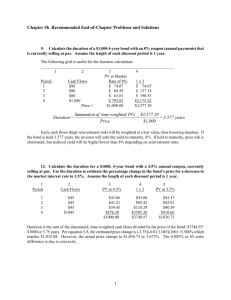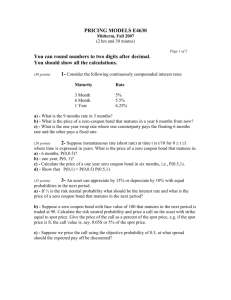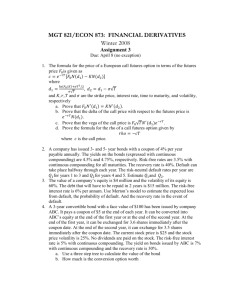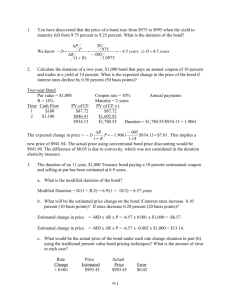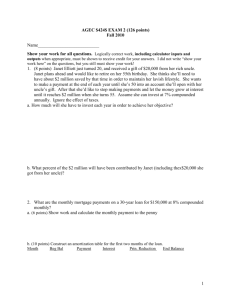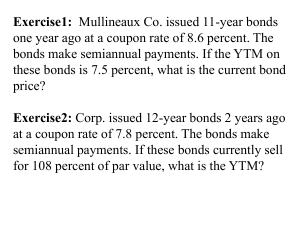Chapter 5a
advertisement
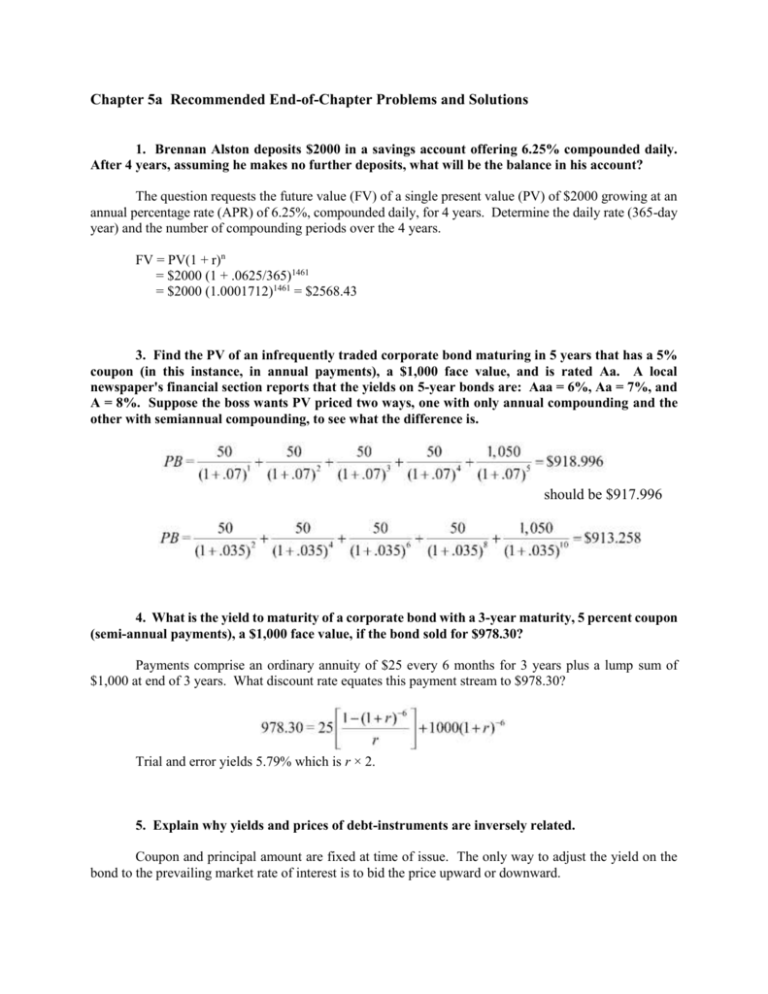
Chapter 5a Recommended End-of-Chapter Problems and Solutions 1. Brennan Alston deposits $2000 in a savings account offering 6.25% compounded daily. After 4 years, assuming he makes no further deposits, what will be the balance in his account? The question requests the future value (FV) of a single present value (PV) of $2000 growing at an annual percentage rate (APR) of 6.25%, compounded daily, for 4 years. Determine the daily rate (365-day year) and the number of compounding periods over the 4 years. FV = PV(1 + r)n = $2000 (1 + .0625/365)1461 = $2000 (1.0001712)1461 = $2568.43 3. Find the PV of an infrequently traded corporate bond maturing in 5 years that has a 5% coupon (in this instance, in annual payments), a $1,000 face value, and is rated Aa. A local newspaper's financial section reports that the yields on 5-year bonds are: Aaa = 6%, Aa = 7%, and A = 8%. Suppose the boss wants PV priced two ways, one with only annual compounding and the other with semiannual compounding, to see what the difference is. should be $917.996 4. What is the yield to maturity of a corporate bond with a 3-year maturity, 5 percent coupon (semi-annual payments), a $1,000 face value, if the bond sold for $978.30? Payments comprise an ordinary annuity of $25 every 6 months for 3 years plus a lump sum of $1,000 at end of 3 years. What discount rate equates this payment stream to $978.30? Trial and error yields 5.79% which is r × 2. 5. Explain why yields and prices of debt-instruments are inversely related. Coupon and principal amount are fixed at time of issue. The only way to adjust the yield on the bond to the prevailing market rate of interest is to bid the price upward or downward. 8. David Hoffman purchases a $1,000 10-year bond with an 8% coupon (semi-annual payments). Yields on comparable bonds are 10%. Bob expects that one year from now, yields on comparable bonds will have declined to 9%. What would Bob’s profit be if he sold in one year? Compute on the basis of semi-annual compounding. The bond would be purchased at: 40 40 1 (1.05) (1.05)2 1040 875.38 (1.05)20 In one year it is expected that the bond would be sold at: 40 40 1 (1.045) (1.045)2 1040 939.20 (1.045)18 for a 80.00 + 63.82 = $143.82 profit (where 80.00 is first-year coupon payments). a. Manhattan Island problem. If the $24 were invested at 3.75% compounded quarterly, what would it have grown to two years ago (after 387 years)? i. You win the $1 million lottery (annuitized, $50,000/yr with first payment today). How much will you get to bring home after taxes if you select lump sum payment? Assume that the lottery commission uses a 6.5% discount rate with annual compounding in its calculations. Assume that 39% will be taken out for state and federal tax purposes. Just setup the math. b. b. What would a 10-year $20,000 zero coupon corporate bond sell for if it is designed to yield 5.6%? It is important with zero coupon corporate bonds to use semiannual compounding. 20000 11,512.4486 (1 .056 / 2) 20 c. What is the monthly payment on a 15-year $200,000 mortgage if the rate is 4.25%? Rearranging the annuity formula, we have r ( PV ) 1 (1 r ) n (.0425 /12)(200000) 1 (1 (.0425 /12)) 15*12 1,504.56 A d. What is the economic value (i.e., full price) of a $5000 10-year, 8% coupon corporate bond except for the fact that no semiannual coupon payments will be made during the first four years of its life? Assume that an appropriate yield for this bond is 12%. Just setup the math. e. Assume a person who has just turned 40. What would be a fair value for a longevity insurance policy that would pay $36,000/yr for 10 years starting when the person turns 65 using a discount rate of 6%? Assuming a 1-yr clock, just set up the math. f. Consider the Outstanding US MM & Bond Market Debt slide. (a) How many times does municipal bond debt appear to be turning over per year? (b) What’s does the average time to maturity for municipal bonds appear to be? • • 365(.012)/3.715 ≈ 1.179 times/yr 3.715/.338 ≈ 10.99 years g. Assume a 6.5% $5,000 semiannual bond. What is the accrued interest on the bond if it has been 63 days since the last coupon payment and the current coupon period consists of 182 days? Accrued interest = 162.50(63/182) = $56.2500 h. Assume a $1,000 3% coupon corporate bond for which the appropriate yield is 6.0%. What is the full price of this bond 2 months before maturity? How would the bond (clean price) be quoted in the newspaper (as a percent of par)? Compute on the basis of a half-year clock. Full Price = 1015/(1 + .03)^(1/3) = $1005.048 Accrued interest = (2/3)15 = $10 Clean price = Full Price - Accrued Interest = $995.048 As listed in the media: 99.5048

